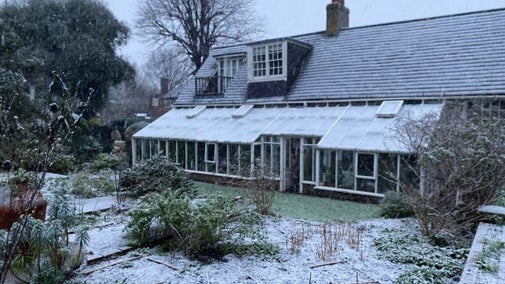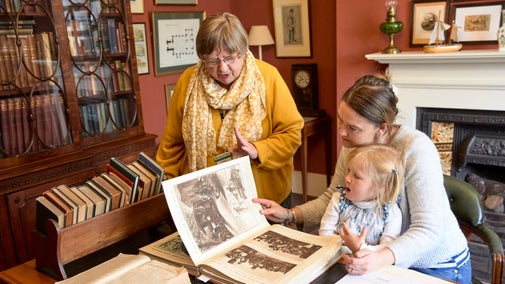
People in history
Discover some of the social history behind the places we care for and uncover fascinating facts about the people who have lived in them.


The Bloomsbury group was a circle of artists, writers and intellectuals in the first half of the 20th century, originating in the Bloomsbury home of Virginia Woolf and her sister Vanessa Bell. Discover the influential members of the group, learn about their modern views, and find connections between Bloomsbury and the special places that we care for today.
Virginia and Vanessa moved from Kensington to Bloomsbury in 1904 after the death of their father, the celebrated writer and critic, Sir Leslie Stephen.
Their original Bloomsbury house, 46 Gordon Square, became a centre of artistic and intellectual activity when their brother, Thoby, brought his Cambridge University ‘Apostles’ friends to the ‘Thursday Evenings’ the sisters hosted. Members included Clive Bell, Leonard Woolf, Lytton Strachey and Saxon Sydney Turner. Around 1910, E. M. Forster, John Maynard Keynes, Duncan Grant and Roger Fry also became prominent members.
At these gatherings everything from the status of art to issues of Britain’s declining empire was subjected to intense scrutiny.
Drawn together in part by the hugely influential philosophy of G.E. Moore, whom Thoby had encountered at Cambridge, the ‘Bloomsberries’ embraced a culture of sexual equality and freedom, informality and fierce intellectual debate, largely at odds with their strict Victorian upbringings.

The heady atmosphere of openness, experiment and intellect produced some of the most significant statements in English modernism – from Strachey’s Eminent Victorians and Keynes’s Economic Consequences of the Peace, to Virginia Woolf’s Mrs Dalloway, and Vanessa Bell and Duncan Grant’s paintings.
It’s no wonder, therefore, that salon hostess Lady Ottoline Morrell, philosopher Bertrand Russell, aristocratic writer Vita Sackville-West and her diplomat husband Harold Nicolson, all attached themselves to the group between 1909 and 1923.
Influential in everything from art and literature to post-colonial politics, the group became the focus of intense dislike in the post-war period.
The group was seen as elitist and self-regarding, despite its origins in the Stephen sisters’ rejection of the socially exclusive upper middle-class world to which their parents had belonged.
While all members of the Bloomsbury group were based in London, they regularly congregated at their various homes in the South Downs: Virginia and Leonard Woolf lived at Monk’s House near Rodmell; Duncan Grant and Vanessa Bell lived at nearby Charleston Farmhouse where they regularly hosted group members and other notable friends; and Maynard Keynes lived at Tilton House with his wife, the Russian ballerina, Lydia Lopokova.
As their attachment to the Sussex landscape attests, the group was profoundly invested in the English countryside. Both the Woolfs and Keynes campaigned to protect the South Downs, while Vanessa Bell and Duncan Grant celebrated its landscapes throughout their artistic careers.
Here are some of the places in the National Trust's care with connections to the Bloomsbury group.

This article was written by Allison Adler Inglis-Taylor. Allison is a researcher from University of Oxford, specialising in English literature, history and culture from 1800 to the present day. She also has research interests in political history and theatre, and is a contributor to the Trusted Source project.

Discover some of the social history behind the places we care for and uncover fascinating facts about the people who have lived in them.

A hub for multi-disciplinary research projects and research engagement at the University of Oxford
Find out more about our Trusted Source articles, which were created in partnership with the University of Oxford, and explore topics related to the special places in our care.

Leonard and Virginia Woolf's 17th-century country retreat

Find out about this 17th-century house and its journey from farmstead to mill-owner’s residence and finally the home and retreat of well-known writers Virginia and Leonard Woolf.

Visit some of the places we look after that have inspired famous writers, playwrights and poets, including the homes of Beatrix Potter, Virginia Woolf and Thomas Hardy.

Throughout history, women artists have had to overcome many obstacles in order to pursue careers in the fine arts. Discover great women artists and their artworks through the collections we care for.

Learn about the remarkable women in history linked to the places in our care, from the political player who helped make Charles II king, to the archaeologist who discovered a 7th-century Saxon ship burial.

Explore a selection from more than half a million books and manuscripts in the collections we care for. Libraries Curator Tim Pye takes a closer look at some of the most significant works.
